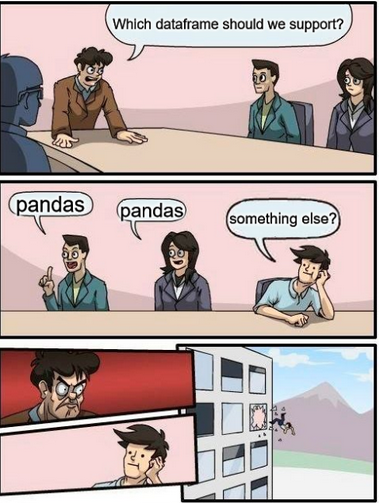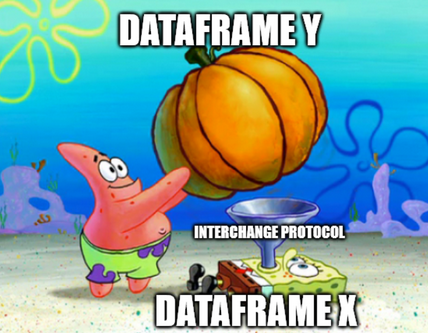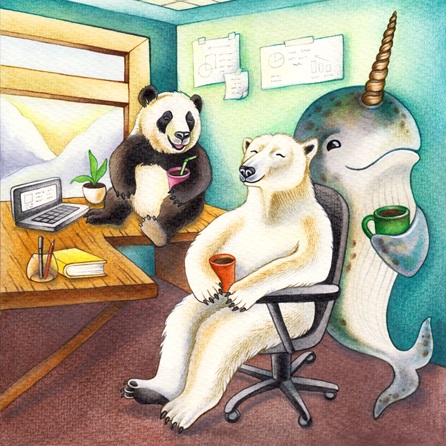Dataframe interoperability - what has been achieved, and what comes next?
Published May 27, 2024
MarcoGorelli
Marco Gorelli
DataFrame Interoperability
I attended PyCon Lithuania 2024, and had a blast! I don't speak Lithuanian, and probably neither did half the attendees. But - so long as we all stuck to a simple and clear subset of the English language - we could all understand each other and exchange ideas. I actually wanted to learn some Lithuanian in preparation for the event, but Duolingo didn't offer such a course, and as a millennial, I was out of options.
Dataframes, like languages, have their similarities and differences, and it's easy to make mistakes. If you learn a bit of Spanish, you might think that "estoy embarazado" means "I'm embarrassed", but it actually means "I'm pregnant". Similarly, after learning a bit of pandas and Polars, you might expect
import pandas as pdimport polars as pdprint((3 in pd.Series([1,2,3])) == (3 in pl.Series([1,2,3])))
to print 'True' - but not so! pandas checks if 3 is in the index, whereas Polars checks
if 3 is in the values.
This little prelude was just to establish two premises:
- writing dataframe-agnostic code is hard!
- a simple and clear common language can enable collaboration
I'll tell you about the dataframe landscape, the interchange protocol, how to write dataframe-agnostic code, and where we might go from here.
pandas is everywhere
There's a great array of diverse dataframes out there. And the way that data science libraries have historically responded to such diversity is to support pandas...

...and nothing else.
This is nice, but comes with four major problems:
- for non-pandas users, they're forced to repeatedly convert to-and-from pandas, which isn't ergonomic;
- for users starting with data on GPU, they need to copy to CPU;
- users working with lazy evaluation need to materialise their data;
- pandas become a de-facto required dependency everywhere.
Before talking about how to solve all 4, let's talk about how to solve at least one of them.
The Dataframe Interchange Protocol
The general idea is "write your library using dataframe Y, and then if a user comes along with dataframe X, then you use the interchange protocol to convert dataframe X to dataframe Y".

Let's look at how to use it - here's how you can convert any dataframe to pandas (so long as it implements the interchange protocol):
import pandas as pddf_pandas = pd.api.interchange.from_dataframe(df_any)
Similarly, to convert to Polars:
import polars as pldf_polars = pl.from_dataframe(df_any)
Note that although the from_dataframe function is standardised,
where it appears in the API isn't, so there's no completely agnostic way
of round-tripping back to your starting dataframe class.
Nonetheless, does it work? Is it reliable?
- Converting to pandas: reliable enough after pandas 2.0.2, though may sometimes
raise unnecessarily in some versions. It's already used by the
seabornandplotlyplotting libraries. - Converting from pandas: unreliable, don't use it. There are cases when the results are "garbage". These have generally been fixed, and will be available in pandas 3.0. For now, however, if you're using the interchange protocol to convert to anything other pandas, then you may want to proceed with great care.
So as of April 2024, the interchange protocol can be used as a standardised version
of to_pandas. Going back to the four problems with only supporting pandas, the
interchange protocol partially addresses the first one (so long as the user doesn't
expect their computation to round-trip back to their original class).
Addressing all four points seems ambitious - is it even possible?
And now for something completely different: Narwhals
Look at how happy this panda and polar bear look, chilling out with their narwhal friend:

As you may have guessed from the image, Narwhals aims to bring pandas, Polars (and more!) together.
The way you write dataframe-agnostic code using Narwhals is:
- Use
narwhals.from_nativeto wrap any dataframe in a Narwhals class. - Use the subset of the Polars API supported by Narwhals.
- Use
narwhals.to_nativeto return the object to the user in its original class.
If you follow these steps, then congrats, your code will work seamlessly across pandas, Polars, Modin, and cuDF. But most importantly, GPU code can stay on GPU, and lazy code can stay lazy!
To see a complete example of Narwhals in action, its website features a little tutorial.
Regarding the four problems of libraries only supporting pandas, Narwhals addresses all of them:
- Users need not do any data conversion manually (in fact, neither does Narwhals, it only translates syntax).
- Data which starts on GPU can stay on GPU.
- Data which starts lazy can stay lazy.
- No heavy dependencies necessary (as we'll soon see, Narwhals is about as light as it gets).
Finally, Narwhals is also extensible, meaning that libraries can become compatible without having to ask any other library to change anything.
Where do we go from here?
We've looked at the dataframe landscape, the interchange protocol, and Narwhals. I'd like to conclude with a wishlist of things I'd like to see happen in the next year. I wish that:
- Data science will become more dataframe-agnostic.
- More libraries will support Polars (and other dataframe libraries) natively, instead of converting to pandas as an intermediate step.
- The Polars API becomes more widespread, as opposed to all libraries trying to imitate pandas.
There's actually one more item on my wishlist. It's way more ambitious than the above ones, and I don't know if we'll ever see it happen. However, I'm a dreamer, so that's not going to stop me from hoping:
- I hope that Duolingo will finally add a Lithuanian course to their catalog.
I look forward to revisiting this post in one year's time to see in which direction data science has gone. Now please go out and use the Polars API!